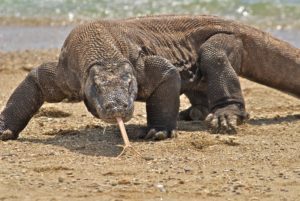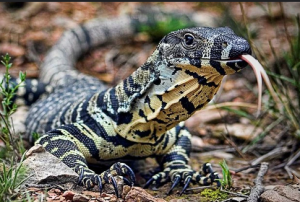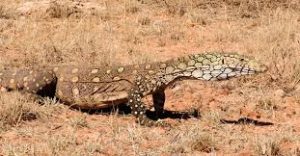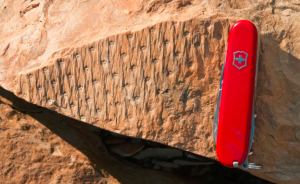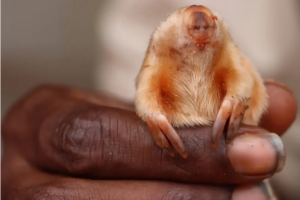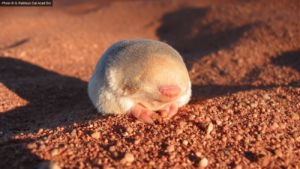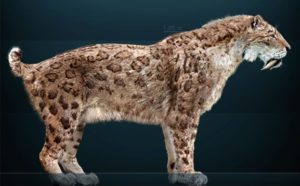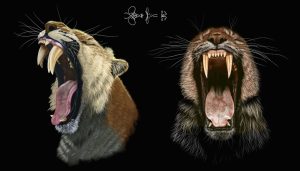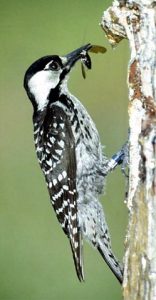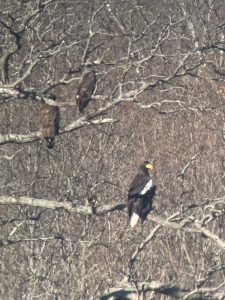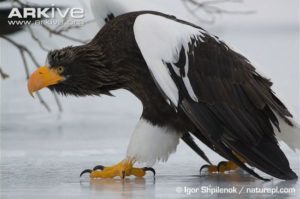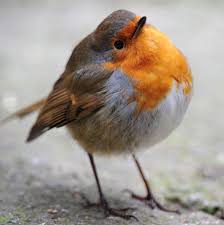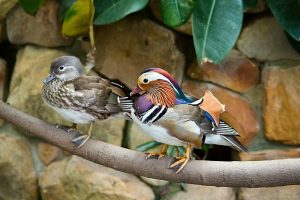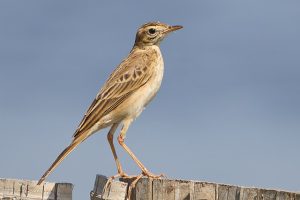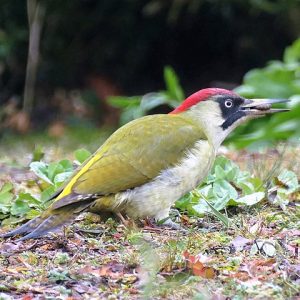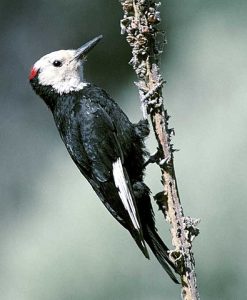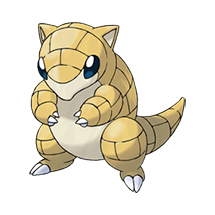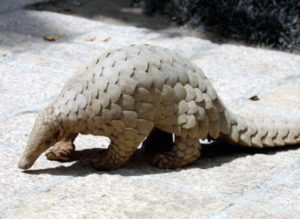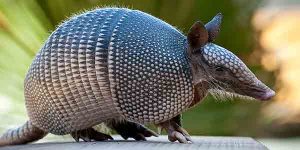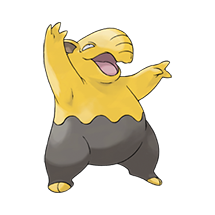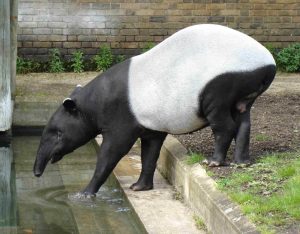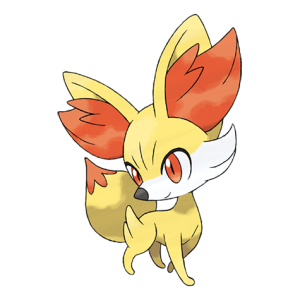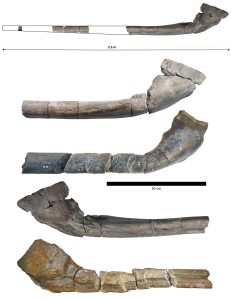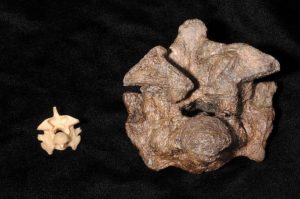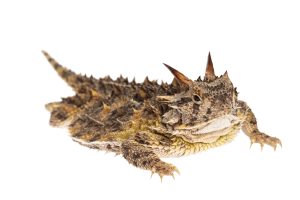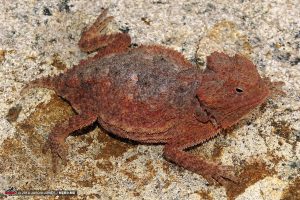Podcast: Play in new window | Download (Duration: 9:18 — 10.3MB)
Thanks to Cosmo and Zachary for suggesting this week’s monitor lizards!
Further reading:
No One Imagined Giant Lizard Nests Would Be This Weird
The Mighty Modifications of the Yellow-Spotted Goanna
The Asian water monitor:
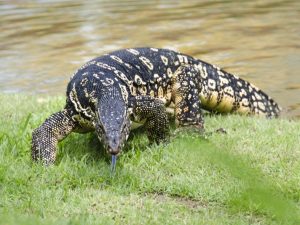
A yellow-spotted goanna standing up [picture by Geowombats – https://www.flickr.com/photos/geowombats/136601260/, CC BY 2.0, https://commons.wikimedia.org/w/index.php?curid=2595566]:
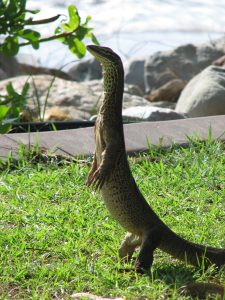
Show transcript:
Welcome to Strange Animals Podcast. I’m your host, Kate Shaw.
Last week we had our big dragons episode where we learned about the Komodo dragon and some of its relations, including goannas. I forgot to thank Cosmo for suggesting the lace monitor, also called the tree goanna, in that episode, and I also forgot that Zachary had also suggested monitor lizards as a topic, so let’s learn about two more monitor lizards this week.
Cosmo is particularly interested in aquatic and semi-aquatic animals, and a lot of monitor lizards are semi-aquatic. Let’s learn about the Asian water monitor first, since it’s the second-largest lizard alive today, only smaller than the Komodo dragon.
The Asian water monitor is common in many parts of South and Southeast Asia, including India, Vietnam, Cambodia, Laos, southern China, and many islands. A half dozen subspecies are currently recognized, although there may be more.
The largest water monitor ever reliably measured was 10 1/2 feet long, or 3.2 meters. It’s dark brown or black with yellow speckles and streaks, and young lizards have larger yellow spots and stripes. It lives wherever it can find fresh or brackish water, from lakes and rivers to swamps, ponds, and even sewers.
Like the crocodile, the Asian water monitor’s tail is flattened from side to side, called lateral compression, and it’s also very strong. It swims by tucking its legs against its sides and propelling itself through the water with its tail. It can dive deeply to find food, and while it prefers fresh water, it will swim in the ocean too. That’s why it’s found on so many islands.
Juvenile Asian water monitors spend most of the time in trees, but even a fully grown lizard will sometimes climb a tree to escape danger. Only saltwater crocodiles and humans kill the adults.
In some parts of its range, the water monitor is killed by humans for its meat and its skin, which is used as leather. In other parts of its range, it’s never bothered since it eats venomous snakes and animals that damage crops. It’s sometimes kept as a pet, although it can grow so big that many people who buy a baby water monitor eventually run out of room to keep it. That’s how so many have ended up in the waterways of Florida and other areas far outside of its natural range, from people letting pets go in the wild even though doing so is illegal and immoral.
While most of the time the water monitor isn’t dangerous to humans, if it feels threatened, it can be quite dangerous. Like the Komodo dragon and other monitor lizards, it’s venomous, plus its teeth are serrated, its jaws are strong, and it has sharp claws. It eats a lot of carrion, along with anything it can catch. A population in Java even enters caves to hunt bats that fall from the ceiling.
Zachary didn’t suggest a particular type of monitor lizard, so let’s learn about the yellow-spotted goanna. Goannas are a type of monitor lizard found in Australia, New Guinea, and some nearby areas. We talked about some of them last week, including Cosmos’s suggestion of the lace monitor, but after the episode was released I found an article I had saved over a year ago. It’s about the yellow-spotted goanna, and a remarkable discovery about how it takes care of its eggs.
The yellow-spotted goanna lives in parts of Australia and southern New Guinea, and a big male can grow up to five feet long, or 1.5 meters. It can swim and climb trees when it wants to, but mainly it stays on the ground, although it prefers to live near water if possible. It’s a fast runner and chases its prey instead of ambushing it. It eats small animals like rodents, birds, fish, insects, and reptiles, including other monitor lizards.
If you remember last week’s episode, the female tree goanna digs a hole into a termite nest to lay her eggs inside. The termites repair the hole in their nest, which means the eggs are nicely hidden from predators and protected from weather, and when the babies hatch they have lots of termites to eat. That’s weird enough, but the yellow-spotted goanna female has an even more interesting way of protecting her eggs.
The yellow-spotted goanna digs a big burrow to hide in, and it spends a lot of its time in the burrow when it’s not out hunting. Researchers assumed the female laid her eggs in the burrow, but every time they investigated a female’s burrow, it was empty.
In 2012, a herpetologist named Sam Doody hoped to figure out where the female hid her eggs. He thought the eggs might be buried inside the burrow. When a female left her burrow, he and his team examined the burrow carefully. Doody noticed that the dirt at the end of the burrow felt softer than the walls, and he dug into it carefully, convinced he would find the eggs right away.
Instead, he and his team kept digging, following the softer dirt. It took them hours and hours, since they had to be really careful, and the filled-in burrow just kept going. It descended five feet, or 1.5 meters, into the ground in a corkscrew shape, more properly called helical, and at the very bottom the team found a nest of ten eggs.
Since then, Doody and his colleagues have studied many other yellow-spotted goanna nests and they’re all helical in shape and as much as 13 feet deep, or 4 meters. The extreme depth is related to how long it takes the eggs to hatch, about 8 months. If the eggs were closer to the surface, they would get too hot and dry to hatch. There’s more moisture and a constant temperature deep underground.
It takes the female more than a week to dig her tunnel and the small nesting chamber at the bottom. She lays her eggs, then returns to the surface, letting the sandy soil collapse behind her to hide and protect the eggs. The females also frequently nest together, sometimes sharing a nesting chamber. Doody’s team once found a nesting chamber as big as a room of your home but only about as tall as a mattress, with more than 100 clutches of eggs laid in it. The females often re-use the same burrows year after year. When the eggs hatch, the baby lizards dig their way out of the nesting chamber–but they dig straight up instead of using the softer parts of the helical structure.
Other animals move into the loose soil of the nesting burrows, especially frogs. When excavating one burrow, Doody’s team found 418 frogs, along with numerous small reptiles, invertebrates, and even mammals, all of them spending the dry season comfortably inside the loose soil in the spiral burrow. I wonder if the mother lizard sometimes digs some of these frogs out to eat as a snack. Watch out, frogs!
You can find Strange Animals Podcast at strangeanimalspodcast.blubrry.net. That’s blueberry without any E’s. If you have questions, comments, or suggestions for future episodes, email us at strangeanimalspodcast@gmail.com. We also have a Patreon at patreon.com/strangeanimalspodcast if you’d like to support us for as little as one dollar a month and get monthly bonus episodes.
Thanks for listening!
